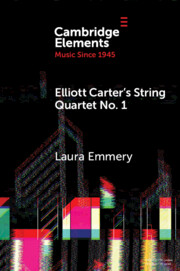Element contents
Elliott Carter's String Quartet No. 1
Published online by Cambridge University Press: 29 November 2024
Summary
Keywords
Information
- Type
- Element
- Information
- Series: Elements in Music since 1945Online ISBN: 9781009537124Publisher: Cambridge University PressPrint publication: 02 January 2025
